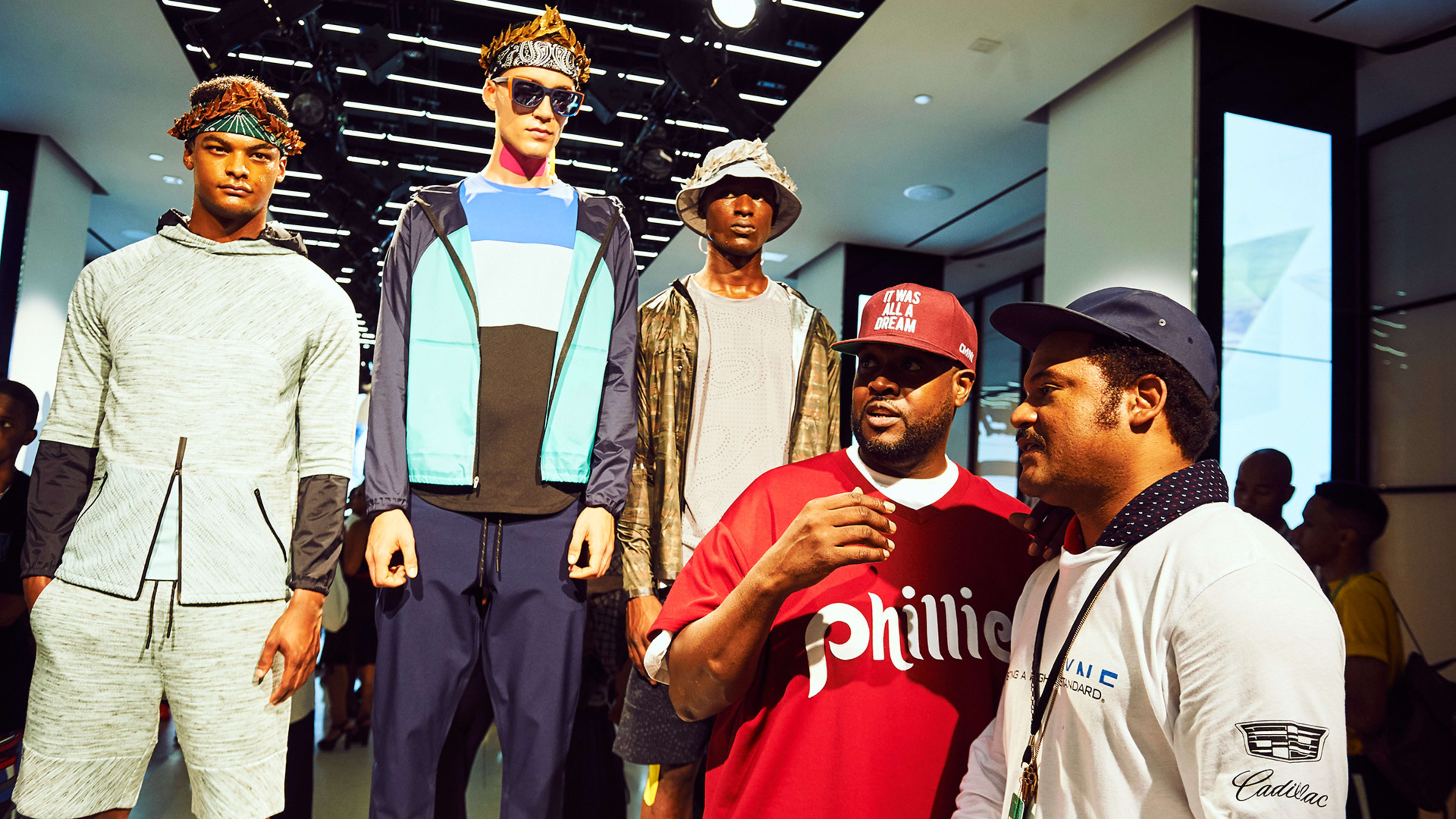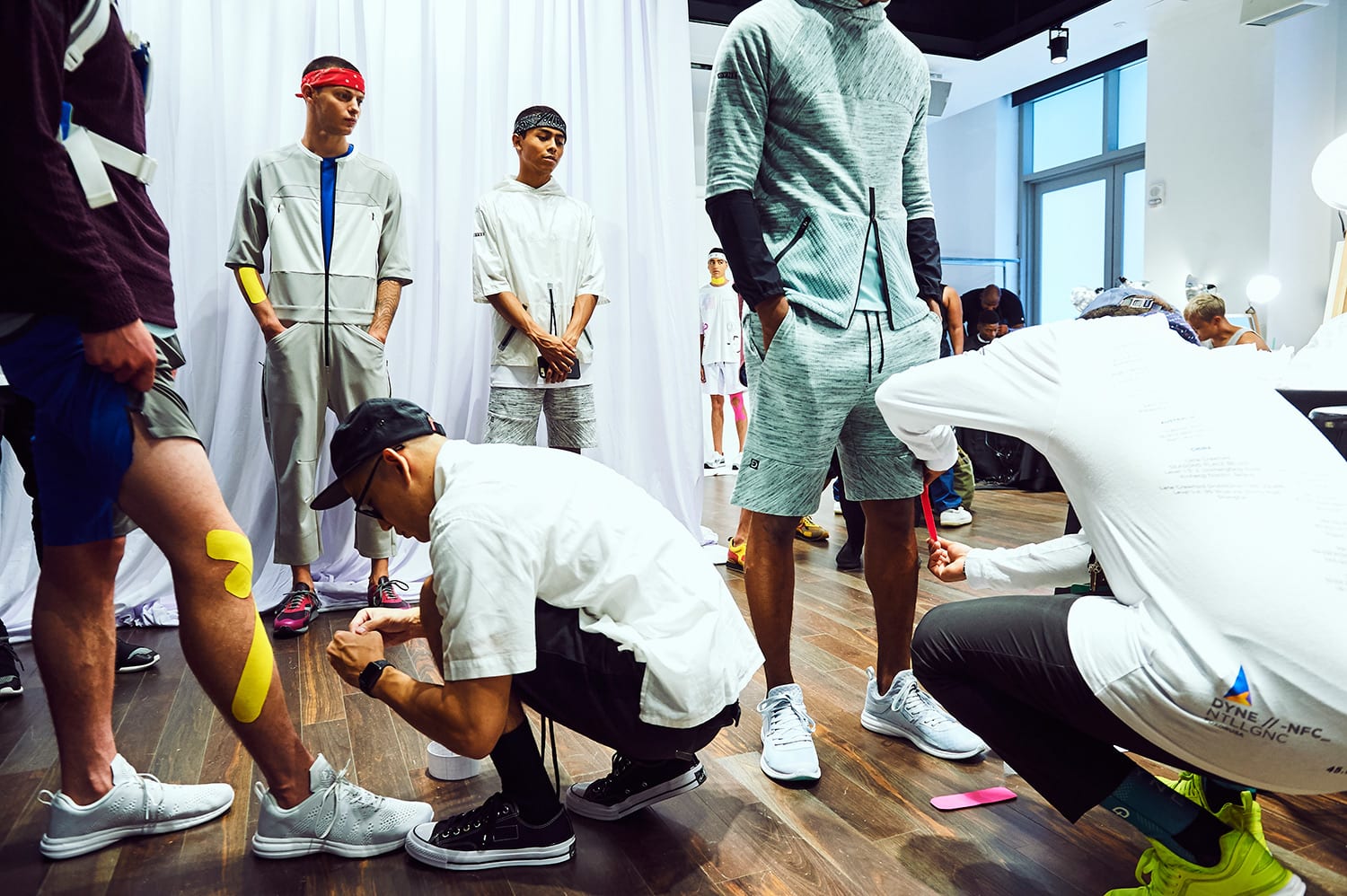When the models in the Dyne Fashion Week show hit the runway last month, they each strutted with a secret that may come as a surprise to fans of the three-year-old streetwear label.
There was something different in the bomber jackets, extra-long windbreakers, and t-shirts with laser-cut perforations. They were Sewfree—fabricated and adorned using, essentially, glue. No thread stitches—not on the pockets, not along the seams.
The use of adhesive gives the clothes smoother lines, a lighter feel, and a sportier look, says Dyne founder Christopher Bevans, who has designed for Rocawear, Nike, and Kanye West.
“We treat life as a sport,” Bevans says. “Our goal is to push the limits of fashion as it meets technology.”

As an added bonus, the adhesive can be used to create design on top of the garments. Throughout the Dyne show, models came out in pieces covered in striking florescent tape. “We’re experimenting with all the uses of adhesives,” Bevans says. “We’re only just getting started.”
Glue Everywhere?
Even if you’re not in the market for high-end streetwear, you might find glue in your t-shirts, underwear, shorts, or jacket. And with clothes makers moving toward increased automation, the use of adhesives could become more practical than sewing robots.
Patagonia, the outdoor clothing and gear maker, is among the companies already turning to Sewfree fabrication. Nichola Napora, an advanced R&D technical designer at the brand, was recently tasked with creating a next-generation coat that would allow a human to better summit the very highest mountains in the world: Everest, Kanchenjunga, Annapurna.
While equipping mountaineers has been part of Patagonia’s mission from the very beginnings of the company, Napora wanted to incorporate the latest in fabric technology and material science to create a garment that could withstand the most extreme conditions, including being submerged in water under freezing conditions. It’s not every day that a designer gets to make a garment whose purpose is to keep a human being alive.
Every last stitch had to be considered. But Napora ultimately decided not to use stitches at all. Instead, she relied on glue, rather than thread, to create seams.
“Stitches create puncture holes that allow water to seep through, whereas glue creates a waterproof barrier,” Napora explains. “But I also love how it creates a high-tech aesthetic. It gives it a sort of futuristic look to not see stitches in your clothing.”
Striking Gold With Glue
For centuries, stitching and sewing have been the primary technologies used to create garments. But over the last five years, brands across the spectrum—from Victoria’s Secret to Nike and Alexander Wang—are increasingly relying on glue to connect fabric, create hems, and incorporate features like pockets and patterns.
Related: Is This Sewing Robot The Future Of Fashion?
The company driving much of this innovation is a little-known family-owned business called Bemis, tucked in the outskirts of Boston and founded more than a century ago.
In the early years, Bemis developed a chemical used in bubble gum, and a leather adhesive was used in shoe manufacturing. But when Steve Howard, Bemis’s CEO, joined the company in 1982, his goal was to find bigger market opportunities. He encouraged his R&D team to focus on other applications of adhesives.
In the early 2000s, Howard spotted a trend. Americans were dressing more casually and incorporating activewear into their everyday wardrobe. Howard predicted that this would only continue, and he believed that Bemis would be able to help brands create more effective garments.
He began to partner with brands like Under Armour and Patagonia one at a time, making the case that gluing fabric together would be more comfortable for the wearer, allow garments to stretch, and provide better protection against the elements. Howard effectively transformed Bemis from a small chemical plant into a multimillion-dollar corporation that has fueled the athleisure movement.
Over the last decade, Howard steered Bemis’s engineers to develop Sewfree technology, which was essentially a double-sided tape that, when activated with heat, could create a strong, waterproof bond between fabrics. Howard believed that this could be a game changer in technical outerwear, then eventually athleisure, which incorporated technical features into everyday garments.
Marketing Glue To Fashion Brands
Howard began to sell the technology to hundreds of apparel brands, including Nike, Lululemon, Gap, Adidas, and Under Armour. These days, Bemis is now found in garments in virtually every American’s closet.
“Once we nailed the technology, we discovered that it had many benefits over traditional sewing,” Howard tells Fast Company. “Bonding can withstand stretching better than sewing, it’s waterproof, and it’s lighter, which are all qualities that are valued by activewear brands. We have to keep innovating every day for every different fabric and every different application, since each needs a slightly different chemical formula.”
I recently visited Bemis headquarters in Shirley, Massachusetts, to see how this fabric innovation takes place. At first glance, the building looks like just another drab concrete plant dotting an industrial town. (This is, after all, where hundreds of gallons of glue are made every day, then shipped off to factories all over the world where brands manufacture apparel.) But after signing a nondisclosure agreement, I’m taken into a secret underground design lab where researchers, designers, and engineers are imagining the future of clothing.

Sally Shultz, an application specialist, regularly embeds herself with brands during the design process. She has just created three dozen little innovations using Bemis technology for an activewear brand’s upcoming collection. (She was not at liberty to say which brand, since the garments have not yet been released.)
“It can sometimes be hard for a brand to imagine what they can do with bonding,” she explains. “So we like to talk to them about problems they are trying to solve, then make tactile mock-ups, which is something they are used to seeing and working with.”
She points to one small pocket, as an example. The brand’s customers love having slots for their cell phones in their shorts, but these pockets tend to rip easily and aren’t waterproof. Pinned to a board is a prototype Shultz has just created of pocket with a securing flap that is bonded to the shorts, making it stronger and impermeable to water.

How Safe Is The Glue?
In a different part of the lab, products are tested for safety. Once the adhesive is activated, it can withstand high temperatures and endless laundering. There are washers and dryers set up to put bonded clothes through hundreds of cycles to make sure that the glue doesn’t degrade or melt. Bemis scientists also make sure that the adhesive doesn’t irritate the skin and the chemicals used in the process don’t harm the body.
Bill Fabiszewski, who worked in Bemis’s sportswear division before becoming a global marketing manager, says that Bemis technology is now incorporated into many professional sports uniforms. He’s seen this transformation firsthand, since he began his career at Reebok in the mid-2000s, where he worked with the NFL to create performance garments.
Fabiszewski says that when it comes to top-tier athletes, the goal is to remove as many distractions as possible from the clothing so they can focus on the game. Seams that rub against the skin can be annoying, so a decade ago, brands began to use a technique called flatlock stitching that creates flat rather than protruding seams.
“Replacing that with bonding creates a whole new world of possibilities,” he says. “There is no friction at all, so hems and seams no longer chafe. It also means they dry faster and are more lightweight, and when it comes to high-performing players, we know that every gram matters.”

Glued Clothes And Robots
Once a brand has decided to incorporate Bemis technology into their clothes, the challenge is for them to make sure that the workers in factories know how to replace sewing with bonding. Bemis is aware that this could be a major hurdle to brands adopting the technology, which is why Howard has set up locations in Vietnam and Hong Kong.
“We’re in these factories all the time helping to implement the technology,” he says. “It used to be hard to go into these factories, since they didn’t want anybody to see behind the walls, but these days, the mentality has shifted. The factories themselves realize it is beneficial for them to be up to speed on the latest fabric innovations.”
If done correctly, bonding can be faster and less labor intensive than sewing. This opens up a world of possibilities when it comes to apparel manufacturing. Sewing robots are already being tested and Bernis envisions adding gluing to to their duties.
As companies think about automating their factories, Howard wants to make sure that bonding is on their radar.
Bemis now has an entire devision devoted to automating the bonding process. Over time, Howard believes that entire garments will be made with glue, rather than stitching, and with minimal human involvement.
Some brands, like Under Armour, are beginning to set up pilot factories in the U.S. that involve a lot of high-tech manufacturing equipment, so Howard’s dream may not be too far off.
“Our goal is to get our process and product into these new factories, to prove that it can work,” Howard says.
Recognize your brand’s excellence by applying to this year’s Brands That Matter Awards before the final deadline, June 7.
Sign up for Brands That Matter notifications here.

























